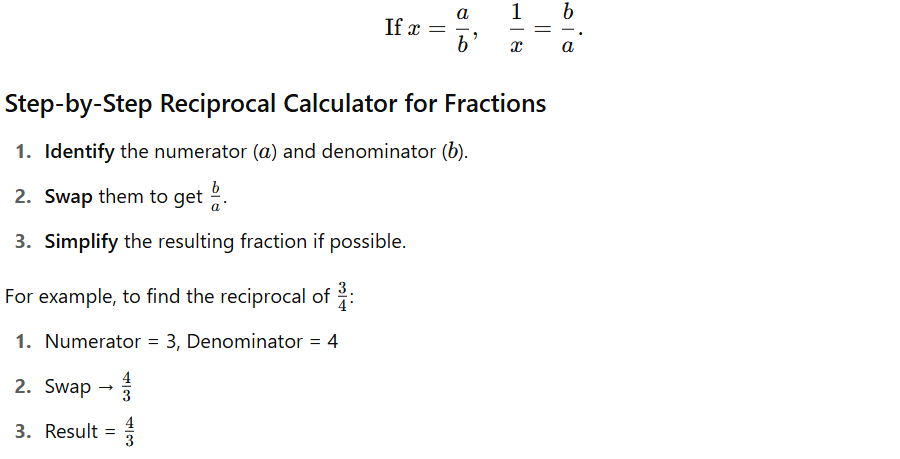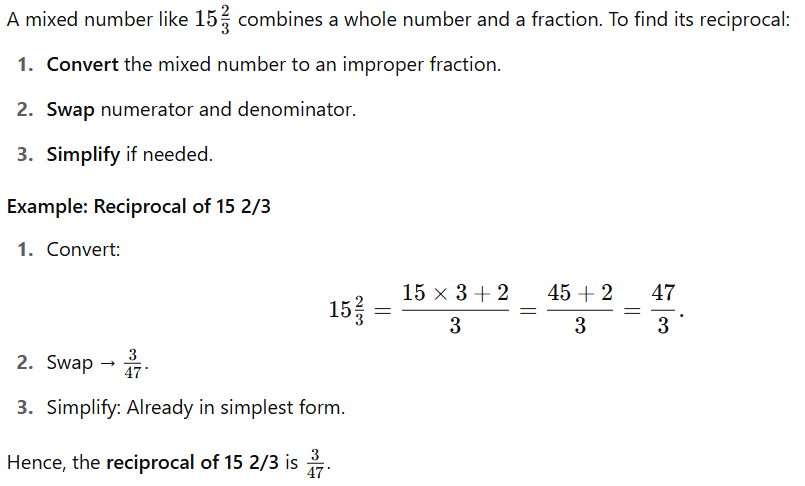🔁 Reciprocal Calculator
The Ultimate Reciprocal Calculator Guide: Compute Reciprocals with Ease
When you need a Reciprocal Calculator to find the multiplicative inverse of any number—be it an integer, fraction, mixed number, or decimal—this comprehensive guide has got you covered. In this article, you’ll discover exactly how to determine a reciprocal manually, plus tips on using various online tools like an Inverse Function Calculator Online, a Reciprocal of Decimal Calculator, or a Reciprocal Calculator for Fractions. Whether you’re asking “what is the reciprocal of 1?” or “reciprocal of 15 2/3,” you’ll find clear, step-by-step instructions here.
What Is a Reciprocal?
A reciprocal (also called a multiplicative inverse) of a nonzero number x is another number which, when multiplied by x, equals 1. In mathematical notation:

Knowing this fundamental definition helps you use any reciprocal calculator or perform the operation by hand.
How to Find Reciprocal of a Fraction
When you have a fraction a/b, its reciprocal is obtained by swapping the numerator and denominator:

This process makes a step-by-step reciprocal calculator in your head quite straightforward.
How to Calculate Reciprocal of Mixed Number

Reciprocal of Decimal: Manual and Calculator Methods
Decimals require a slightly different approach, but the concept is the same:
Express the decimal as a fraction.
Swap numerator and denominator.
Convert back to decimal if desired.
Example: Reciprocal of 0.25

Using Online Tools for Quick Results
While manual methods reinforce understanding, modern learners often turn to specialized calculators:
Reciprocal Calculator for Fractions: Paste any fraction, get the inverse in one click.
Reciprocal of Decimal Calculator: Enter decimals like 0.75 or 2.5, and see results immediately.
Inverse Function Calculator Online: For advanced math students dealing with functions, this tool finds reciprocals of function expressions.
These tools aren’t just convenient; they help you verify your manual work and save time in homework or professional calculations.
Common “What Is” Queries
-
What is the reciprocal of 1?
Since1 × 1 = 1, the reciprocal of 1 is 1. -
Reciprocal of 15 2/3
-
Convert the mixed number to an improper fraction:
15 2/3 = (15 × 3 + 2) / 3 = 47/3 -
Swap numerator and denominator:
1 / (15 2/3) = 3/47
-
Convert the mixed number to an improper fraction:
-
How to find reciprocal of a fraction
- Identify the fraction,
a/b. - Swap numerator and denominator to get
b/a. - Simplify if possible.
3/5 → reciprocal = 5/3. - Identify the fraction,
-
How to calculate reciprocal of a mixed number
-
Convert the mixed number
W a/bto an improper fraction:
(W × b + a) / b - Swap numerator and denominator.
- Simplify if possible.
2 3/4:
2 3/4 = (2 × 4 + 3) / 4 = 11/4 → reciprocal = 4/11. -
Convert the mixed number
Manual vs. Automatic: Why Learn Both?
Learning the Manual Method:
Strengthens number sense.
Reduces reliance on electronic devices.
Essential for exams where calculators aren’t allowed.
Using an Automatic Reciprocal Calculator:
Speeds up repetitive tasks.
Reduces human error.
Ideal for large data sets or complex functions.
Balancing both approaches ensures you’re prepared whether you’re offline or need maximum efficiency online.
Tips for Remembering Reciprocal Rules
Flip and Simplify: Always flip numerator and denominator.
Zero Is Off-Limits: Zero has no reciprocal—division by zero is undefined.
Check with Multiplication: Multiply the original number by your result; you should get 1.
Practice with Mixes: Work examples with fractions, mixed numbers, and decimals to build confidence.
Beyond the Basics: Advanced Applications
Reciprocals appear in various advanced fields:
Physics: Calculating resistances in parallel circuits uses the sum of reciprocals.
Finance: Risk analysis sometimes involves reciprocals for rate conversions.
Statistics: In regression, reciprocal transformations stabilize variance.
Understanding the core concept and having a reliable step-by-step reciprocal calculator at your disposal empowers you to tackle these real‑world problems.
Conclusion
Whether you’re curious about the reciprocal of 1, mastering how to find the reciprocal of a fraction, or tackling reciprocal of decimal calculator challenges, the principles remain consistent: flip, simplify, and verify. By combining manual practice with powerful online tools—such as a Reciprocal Calculator or an Inverse Function Calculator Online—you’ll develop both speed and deeper understanding. Bookmark this guide, and next time you need to calculate the multiplicative inverse of any number, you’ll know exactly where to look and how to do the math, both by hand and with the best calculators available.
